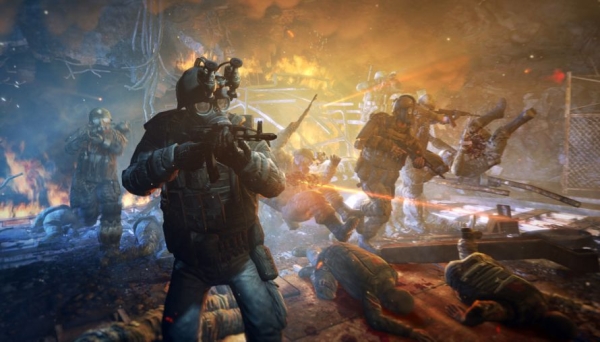
Metro: Last Light – New Demo Reveals Details [E3 2012]
Metro: Last Light didn’t make an appearance at any of E3’s pre-show press conferences, nor did it even appear on the show floor. Instead it was tucked away in THQ’s meeting room on the third floor of the Los Angeles Convention Center, in a cozy room with eight seats facing a big screen TV and a small desk where a member of the development team sat, ready to play through its twenty minute long demo. There were no sports cars emblazoned with its logo and no cosplaying models trying to woo you into an impressionable state, and they didn’t need either. Metro: Last Light was impressive enough all on its own.
Before we were guided through the demo, one of the designers gave us a quick introduction. The team at Ukraine based 4A Games, he said, were tired of seeing so many shooters were the single player game was just a “shooting gallery” that was “training for multiplayer.” Metro was first and foremost to be an immersive single player experience, and you can’t be immersive without having an atmosphere that pulls you into it. Today, atmosphere was what this demo of Metro was going to be all about.
The first thing that you’ll notice about Metro was its complete and utter lack of a HUD, pop ups or command prompts. This is not entirely new information, as 2010’s Metro 2033 had almost no HUD on higher difficulties, but I cannot stress it enough. Not once in the entire demo did we see any of those elements for even an instant, not even crosshairs. The only thing even remotely related to these now standard video game tropes was that items you could pick up glowed faintly. Otherwise, the game used other creative methods to feed the player information. For example, Metro often requires players to don gas masks in order to survive in certain areas of post-apocalyptic Russia, but players must frequently replace their mask’s filters or face suffocation. The amount of time you have left on your current set of filters is represented not by a HUD element, but by a watch the player-character wears on their wrist. Instead of a bullet count in the top left corner of the screen, players can judge how much ammo is in the clip of their machine gun by actually counting the bullets left in its side-fed magazine as it slides through the chamber.
But even though you have that big machine gun, in Metro: Last Light, you’re still only human. You’re neither a Rambo style action hero or a ‘roided up space marine. You wipe the blood from your visor just like everyone else. Literally, you have to wipe the blood from your visor. Not just blood, but water and the occasional spider, too. If you don’t, your vision will be obscured, and very soon one of Metro’s man sized rats, mutated mutts or winged “demons” will make you very dead. It may be just a little detail, but the kind of fear and panic it can create in the heat of battle or when walking down a dark corridor should not be underestimated. It also says a lot about Metro’s atmosphere –you’re vulnerable. When you take damage with your gas mask on, your mask cracks, and if it breaks at the wrong time, you’re done. That big gun in your hand doesn’t make you invincible. It just gives you a chance to survive.
Another big part of Metro’s atmosphere is the setting. As our guide from 4A Games pointed out before the demo, most post-apocalyptic games draw from Western themes. We often find ourselves in a Mad Max style wasteland roamed by colorful gangs of bandits and dune buggies. Metro has a somewhat different flavor, and its post-apocalyptic Moscow is more like a kind of urban hell. Light is hard to come by, even on the surface where it was nearly blotted out by storms for the duration of the demo. The result is a world that looks like the color – and by extension the life – has been sucked out of it, leaving only a withered husk of steel and concrete roamed by mutated abominations.
All this is done with some noteworthy technical finesse as well. At one point in the demo, a point blank shotgun blast blew a mutant to pieces, and the resulting carnage left drops of blood actually dripping from the ceiling, which could then fall on the player’s mask. The lighting effects were also handled with finesse, which is something that becomes more important in a game where there is little light to begin with. The soft glow from an abandoned oil lamp that the player lit was warm and illuminating but not strong enough to truly vanquish the darkness, and it cast some very sharp dynamic shadows from the player and the objects around it. There were no technical hiccups from texture dropping or frame-rate slowdown, either. It’s hard to quantify all this without being able to show you the game in action, but from where I was sitting it looked technically excellent.
Granted, this was not a hands-on demo, so I cannot make a real judgment on the game’s combat, but it at least looked smooth during the demo. Ultimately, it’s impossible to say just how good the game is before getting our hands on it ourselves, but what 4A Games showed was among the most impressive presentations of the entire show, let alone within the FPS category. This may very well be the home-run that THQ has been looking for. Keep an eye on Metro: Last Light as it gets closer to its release date in early 2013.



